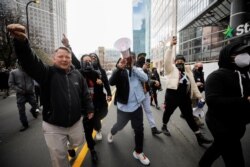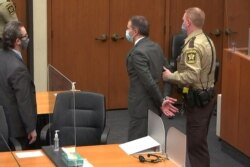A jury of five men and seven women found a former Minneapolis officer guilty of murder and manslaughter Tuesday in the death of George Floyd.
The jury, including six white people and six people of color, spent about 10 hours to reach the verdict from the three-week trial. They found Derek Chauvin, the former police officer, guilty of all three charges of second-degree murder, third-degree murder and second-degree manslaughter. Chauvin could face up to 40 years in jail for the second-degree murder charge alone.
Floyd, a Black man, died last May after Chauvin, a white police officer, pressed a knee on his neck for about 9 minutes 29 seconds. Floyd’s death led to nationwide protests against racism and policing in the United States. Some of the protests turned violent and led to property damage and injuries.
George Floyd’s family released a statement through their lawyer. It said, “This case is a turning point in American history for accountability of law enforcement and sends a clear message we hope is heard clearly in every city and every state.” They also shared a video of their phone call with President Joe Biden and Vice President Kamala Harris after the verdict.
Speaking from the White House later in the day, Vice President Harris said, "Today we feel a sigh of relief. Still, it cannot take away the pain. A measure of justice isn't the same as equal justice.” She added, “This verdict brings us a step closer, and the fact is, we still have work to do. We still must reform the system.”
President Biden called the verdict "a giant step forward in the march towards justice in America." He compared the knee on Floyd’s neck to “the knee on the neck of justice for Black Americans.”
Outside the courthouse and at the street corner where Floyd was killed, people cheered the news with calls of “justice” and “Black Lives Matter.” Others ran through the streets waving signs and cars sounded their horns.
Across the nation, officials had been concerned about the possibility of violence. Armed National Guard and law enforcement had been activated to guard against a repeat of last year’s riots in some areas including Minneapolis.
In its closing arguments, the government showed video of Chauvin with his knee on Floyd’s neck for nine minutes and 29 seconds. In the video, Floyd could be heard repeatedly saying, “I can’t breathe...” A government lawyer told the jury, “This case is exactly what you thought when you saw it first, when you saw that video."
The defense asked the jury to consider that Chauvin was answering an emergency call about a male suspect who used fake money and appeared to be “under the influence,” of drugs. A defense lawyer said, “All of the evidence shows that Mr. Chauvin thought he was following his training…He was following Minneapolis police department policies. He was trained this way.”
Speaking to reporters, Minnesota Attorney General Keith Ellison thanked the witnesses who recorded the video and testified in the case. He said they “raised their voices because they knew that what they were seeing was wrong,” and then ”told the whole world” what they saw.
After the verdict was announced in the courtroom, a court officer asked the former police officer, “ Mr. Chauvin, please place your hands behind your back.” He then handcuffed the former Minneapolis police officer’s left hand, then his right hand, and led him away.
I’m Caty Weaver.
Hai Do wrote this report for VOA Learning English. Mario Ritter Jr. was the editor.
________________________________________________
Words in This Story
verdict –n. the decision made by a jury in a trial
accountability –n. responsibility for something
horn –n. a device that makes a loud sound
fake –n. meant to look real or genuine but not real
We want to hear from you. Write to us in the Comments section, and visit our Facebook page.















